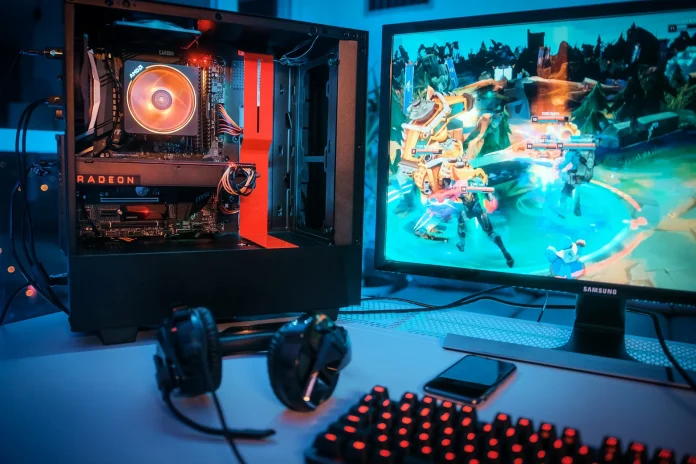In the traditional fashion of answering the burning questions here at Talkesport, we’re here to address the next new question – SSD vs HDD for gamers, which one should you choose and why?
Just like we recently explored which CPU and GPUs provide the best performance for your gaming build, the selection of a good storage solution will definitely influence your PC’s gaming performance. How you may ask, well here’s how.
A speedy SSD can cut down your loading times (yes, the annoying intermediate screens that pop up just at the wrong times) and your overall system responsiveness, whereas a wrong HDD with a slow “read” head – can prolong your wait times in every gaming session
So, choose wisely when selecting a HDD versus a SSD for gaming – as it has also got to do a lot with your budget and your objectives.
In simple terms, what we’re trying to do here is to outline the benefits of how a hybrid solution of both HDDs (traditional hard drives) and SSDs (solid state drives) can benefit your gaming rig.
SSDs are usually for performance and HDDs are more “capacity” oriented.
What is a SSD?
SSDs or Solid state drives, are flash memory devices that store data at enormous write and read speeds – which means no physically moving parts. Their read and write speeds are way higher than HDDs and their solid nature also means – lower chances of “breaking” due to physical damage, but at the cost of higher cost per gigabyte of storage.
What is a HDD?
Hard disk drives – on the other hand utilise spinning magnetic media to save data, which is retrieved by a read/write head on an actuator arm (sorry, my editor asked me to include the technical jargon) – so simply put, a reader head sits on top of a disk like a record player. This causes slower read/write rates, elevated access times and a lower cost per gigabyte of storage – when compared to SSDs
Understanding Storage Performance

Well for gaming, the most prevalent metrics for evaluating a storage device’s performance are the read/write speeds – essentially how much time it takes for the device to receive, store and retrieve data from memory.
Sequential read/write speeds are the most widely used performance measures which reflect scenarios where large blocks of data are transferred – sequentially especially when you’re copying and pasting large files within your computer. These transfers are usually quantified in MB/s (Megabytes per second)
Random read/write speeds involve data situated in random blocks across drives, meaning they require more time to read or write compared to sequential blocks. This metric accurately represents typical usage due to games and other applications that have files that expand on execution – to read and write smaller files to the disk and access data that isn’t exactly organized – in a sequence. This metric for speeds in such operations is called IOPS or Input/output operations per second.
Synthetic benchmarks are commonly utilized to promote storage drives, but these tests should be interpreted cautiously — they may not always reflect actual performance. Manufacturers might showcase the drive’s peak performance by testing at a high queue depth (the number of actions performed in sequence), such as 32, even if a queue depth of 8 or lower would be more realistic for most users.
Coming to the question once you’ve convinced yourself that SSDs are the better choice, which is –
Which kind of SSD? SATA SSD vs NVMe SSD
That’s a whole new block of jargon isn’t it? Let’s break it down. SSDs usually come in two connection types – SATA III & NVMe.
NVMe rapidly is being adopted in all out of the box devices in the industry but it’s always beneficial to know the why behind this.
SATA III (Serial ATA) is a cable that operates with the SATA protocol to connect many older SSDs and HDDs to the PC’s motherboard.
NVMe (Non-Volatile Memory Express) is a fairly recent protocol that permits direct connection to the motherboard’s PCIe lanes, allowing higher throughput and reduced latency. PCIe 3.0 and 4.0 drives transfer data at thousands of megabytes per second – much quicker than SATA III — with PCIe 4.0 drives approximately doubling the bandwidth of the 3.0 standards.
But do note that gamers with older rigs & essentially older motherboards and BIOS – may lack support for NVMe drives so make sure to check for compatibility before making the jump. You can verify this by consulting your motherboard documentation or searching for your motherboard’s specifications online.
What are the different form factors for a SSD?
Form factors for SSDs are more than just physical features of the hardware. They are also how the drives connect and communicate with the motherboard.
Starting with,
The 2.5 inch
2.5-inch SSDs appear similar to 2.5-inch mechanical drives. Do note that size doesn’t matter in this case. Consumer drives generally utilize the SATA III protocol and necessitate separate power and data cables. NVMe, however, is quickly establishing itself as the new standard for consumer SSDs.
The M.2
M.2 drives are designed like small, thin rectangles, often likened to sticks of gum. They connect directly into an M.2 slot on the motherboard. (Usually oriented towards laptop upgradation users – where they compactly, directly plug into your laptop’s motherboard). Typically, they utilize the NVMe transfer protocol, though some older devices might use SATA. Additionally, M.2 connectors are engineered differently to prevent use with incompatible sockets.
M.2 slots may be positioned beneath thermal shields or even on the backside of Mini-ITX motherboards. If you’re struggling to find M.2 slots, consult your motherboard’s documentation.
The AIC
AIC (Add In Card) SSDs link to a PCIe slot on the motherboard for power and data. They utilize PCIe lanes to communicate directly with the system, just like an NVMe M.2 SSD.
If your system lacks an available M.2 slot, AIC SSDs may also function as PCIe-to-M.2 adapters.
If you liked this guide on which drive – a HDD or a SSD is better for your gaming PC, do bookmark Talkesport & keep watching this space for more!


